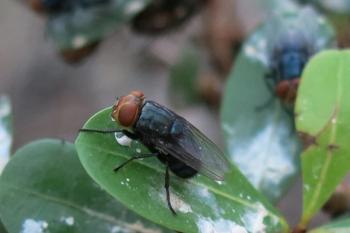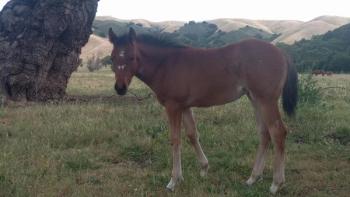
Unconfirmed toxins color perspectives
DVMs sort through endless discussions of caterpillars and cherry trees in search of final answer to perplexing horse syndrome
Mare Reproductive Loss Syndrome (MRLS) has some equine veterinarians questioning the alleged cause of the affliction two months after it claimed the lives of more than 525 foals in Kentucky, West Virginia and Ohio.
Investigators at the University of Kentucky have linked a "cyanidetheory" to the syndrome that was responsible for a surge in late-gestationfoal losses and early-term fetal losses from late April to late May. (See"Gluck rules out Mycotoxins...", DVM July, 2001 p.1)
The theory asserts that Eastern tent caterpillars, which had been livingin cyanide-tainted cherry trees, somehow transferred the cyanide to grazinghorses. The trees' leaves wilted following a drought, causing caterpillarsto fall into the pastures. The tree leaves are a likely source of the toxins,although officials are also looking at a hemlock link.
"I think everybody is very hopeful that (the cyanide theory) isthe cause, because that is something we can deal with," says Dr. TomRiddle, founding partner of Rood & Riddle Equine Hospital and the firstveterinarian to focus on the early fetal loss problem. "(But) thereis some skepticism that we may not be at the bottom of the cause yet."
He makes reference to a similar fetal loss incident that occurred onnumerous farms in Central Kentucky in 1981. Large numbers of mares abortedin this case as well.
"No definite cause was ever found for that outbreak," Riddleadds.
Dr. Kim Sprayberry, an internist at Hagyard-Davidson-McGee, says blamemay not end with the tent caterpillar.
"Some veterinarians do not think this is necessarily the end ofthe story or the whole story," Sprayberry says. "There is stillother information that should be pursued, and the search for etiology shouldreally not end here."
There has been little mention of how pericarditis, uveitis and the reproductiveloss are all linked, she says.
"Could the cyanogenic compounds cause all these things?" Sprayberryasks. "There are as many questions raised by this theory as are answeredby it.
"I think the tent caterpillar and cyanogenic theory may play a role,"she says. "In many ways it fits the time course, and cyanogenic compoundshave been found in the heart muscle of some aborted foals. But there arestill enough unanswered questions that it would behoove us all to keep lookingand leave no stone unturned in the search for other possible causes."
'No room for error'
If the cyanide theory is wrong, Dr. Doug Byars, director of internalmedicine at Hagyard-Davidson-McGee, says there is "no room for error."
Even though he says he has a "tremendous amount of confidence"in the cyanide theory proposed by Dr. Lenn Harrison at the Kentucky DiagnosticLaboratory, he still strongly believes "this needs to be sorted outdefinitively so we can have restored confidence in the industry here inKentucky." He cites the number of horse owners who already have transportedtheir horses elsewhere because of the significant loss in the state.
At presstime, Byars had a more pressing concern, which was reported bythe Associated Press. He says he still sees many cases of horses with inflamedhearts (pericarditis), while the loss of foals and fetuses has eased up.
Byars says he normally treats two or three pericarditis cases a year.But in early June five new cases were sent to the clinic, and in the lastmonth, an increase of 10 times the number of pericarditis cases were broughtin.
The illnesses leave some officials questioning whether an undiscoveredtoxin is also involved.
Don't expect an easy answer to the complex syndrome, says Dr. Roger Murphy,independent practitioner and president of the Kentucky Veterinary MedicalAssociation and Kentucky Association of Equine Practitioners.
"Basically the general consent is that this was not a problem createdby a single entity," he says. "This was a multi-faceted attackon the reproductive systems and other systems of the horses in this areathrough a combination of several different aspects - the mycotoxin, cyanide,fescue, endophyte problems."
Drought likely significantly affected the level of cyanide precursorin the cherry trees as well as the influx of the overwhelming number ofcaterpillars that developed in the face of the drought, Murphy says.
The "final straw," he says, was the cyanide.
Other surfacing theories
Prior to the cyanogenic compound theory, veterinarians learned that thedestructive agent could be a mycotoxin, fungal endophyte, phyto-estrogenor other "bad compound" from the pastures. Mycotoxins are knownto negatively impact reproduction and growth rates in species, accordingto University of Kentucky researchers.
Scientists examined the mycotoxin and other fungal possibilities closelyafter Kentucky endured an unusual weather pattern this spring consistingof warm, wet weather followed by frost (mid-April), then drought.
"The freak (ice) storm is the one reason why people initially focusedon it being a plant-related toxin, because the climatic conditions fit that,"says Sprayberry. "When you see epidemics of animal toxicity or animalpoisoning, it's after a bout of severe drought or a freeze or somethingthat damages the plants."
Mares were initially given mycotoxin binders, forbidden to graze andtreated to preserve pregnancy. Early ELISA tests showed positive for zearalenone,a mycotoxin, but later extensive testing disproved the results.
Prepared for worst
Throughout the ongoing investigation, veterinarians across the stateand in the Ohio Valley took charge of the situation.
"I think that this (incident) has made us even more aware of howan unknown problem can crop up seemingly from nowhere and have a devastatingeffect on our practices," says Riddle. "I'd like to think thatthe next time something like this happens, we'll all be a little betterprepared to organize ourselves and search for an answer."
Nevertheless, he credits the University of Kentucky for its thoroughnessin maintaining a Web site for the public and updating veterinarians on thelatest information.
Murphy of the KVMA and KAEP believes if the incident was going to happen,only one place housed all the resources.
"If it (MRLS) had to occur in the industry, (Kentucky) is the bestplace for it to occur. Here we are able to investigate it, control it andeliminate it in the future," he says. "We have every internationalor renowned internal medicine person in the equine industry located herein three or four of the facilities.
"The research done at the (University of Kentucky) diagnostic laband Gluck Center as well as the level of practice in this area is actuallywhat brought this to the attention of the necessary people to find out whatis going on. If this had happened anywhere else in the world, it would havehad a heck of a lot more impact on the industry than it has here,"he says.
But Sprayberry has some bones to pick with the investigational process."What does not exist right now is a prompt conduit of information fromthe Gluck Center investigators to the practitioners who are seeing the casesin the field and in the hospitals."
Sprayberry faults officials from the University of Kentucky Gluck Centerfor delaying the release of information to the large veterinary practicesin Kentucky responsible for treating the stricken mares.
Instead, Sprayberry recognizes the veterinarians in the field and especiallythe two large veterinary referral clinics - Hagyard-Davidson-McGee and Roodand Riddle as "sentinels" for the syndromes. "We see moreof it than anyone, and have maybe a better appreciation for the scope ofthe problem than anyone, but there is still ineffective communication betweenpractitioners and investigators."
Dean M. Scott Smith of the College of Agriculture at the University ofKentucky addresses her concerns: "The constant dialogue and sharingof information between equine practitioners, the scientific investigatingteam and farm owners and managers has been crucial in allowing the investigationto move forward at a rapid pace.
"During the initial rush and urgency associated with the first severaldays of MRLS, some communications may have missed connecting with veterinarianswho needed it," he says. "Since then, several measures have beentaken to give practitioners more timely and direct information."
Teamwork
When cases of MRLS started cropping up, the Kentucky Association of EquinePractitioners re-activated a group - the Emerging Disease Committee - tomeet and advise fellow veterinarians what to do, what samples to submitand how to report losses. Members of the diagnostic facilities, field veterinarians,internal medicine specialists and the KVMA and KAEP represent the committee.
The meetings of various groups have resulted in immediate action, reportsDr. Bill Bernard of Rood & Riddle.
"We have had meetings on recommendations of the best therapy, howto approach it, and how to proceed with ongoing investigations."
However, he says all the various meetings have posed their own set ofproblems. "Part of the problem is that different groups are havingmeetings and sometimes information needs to be shared a little better thanit is, but we are working on it."
Aside from meetings, the KVMA and KAEP have jointly coordinated the disseminationof data from the research diagnostic facilities, such as the Gluck Centerand the Diagnostic Lab, and field service veterinarians, to the farm managers.
"We are the liaison for the different factions to try to draw everythingtogether for collection and dissemination of information to the veterinarycommunity," says Murphy, president of both associations. "Ourpurpose is not to keep the public informedit's to keep the membership informedof the status of the latest testing and how things are going among differentfield veterinarians to see the infant rate (increase or decrease). We aremainly a coordinating reference."
Most recently, the associations disseminated the latest results of thediagnostic lab testing of tissue and blood samples and conducted a jointmeeting of the public, farm managers and veterinarians. Information fromthose entities was faxed to KAEP membership 24 hours in advance of the restof the world.
"We are networking fairly closely with the membership to try andkeep all the information fed into the machine so we can draw a correlationon the epidemiology of what is going on."
Murphy and others in the industry now await the results of an epidemiologicalsurvey, headed by Dr. Roberta Dwyer of the University of Kentucky, who iscoordinating with the USDA. On May 31, the team traveled to 150 farms, includingthose farms that experienced significant foal/fetus losses and those thatdid not. Surveys were conducted by more than 20 veterinarians, state andfederal animal health employees and other volunteers. The plan was to collectall data by June 6. At presstime, results were not available.
In the field
In addition to association meetings and search committee investigations,veterinarians have been toiling in the field working "ungodly hoursunder emotionally difficult circumstances" says Sprayberry.
And Riddle says one of the greatest obstacles to addressing the syndromethus far is lack of conclusive facts.
"It is very difficult to make recommendations for practical managementof our mares, which are pregnant from this year's breedings because we donot know the (definitive) cause of the abortions."
Even though veterinarians are assisting in every way they can, the emotionalloss can be tremendous and overwhelming for the clients.
To assist clients in this time of grief, veterinarians from Rood andRiddle Equine Hospital and several other community groups sponsored a prayerservice for the horse industry in early June. The goal of the event, accordingto organizers, was to "simply reach out and try to comfort and encouragethe owners and caregivers of these horses."
Under all the pressure, Byars of Hagyard-Davidson-McGee tips his hatto the behind-the-scenes individuals.
"Support staff, people at farms, veterinarians, have all hunkereddown and worked their hearts and souls behind these horses. A lot of thegrassroots people have been wonderful," he says.
All these individuals have maintained a somewhat optimistic approachin the face of grave statistics.
"We may face as high as one-third of our population (foals) notbeing present (next year)," says Byars. "When you hear of 500foals that may not sound like many, but (it's a different story) when youattach that to thousands of foals that will not be born next year."
Newsletter
From exam room tips to practice management insights, get trusted veterinary news delivered straight to your inbox—subscribe to dvm360.






